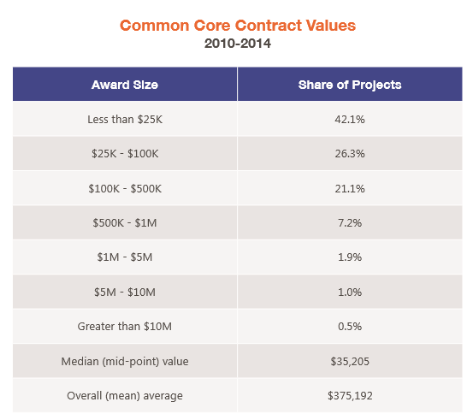Common Core Contracting Shows Uneven Trends, Study Finds
An analysis of contracting for common core-related materials shows a limited number of states accounted for the 600 opportunities in 2012 and 2013, with many other states showing no activity so far, according to Paul Irby, a market analyst at Onvia, a Seattle-based government business intelligence company.
Eleven states made at least 10 common core-related contracting awards in the last two years, while 20 states have had no awards, or only one, according to Onvia’s review of bids, requests for proposal (RFPs), and awarded contracts in its proprietary database of government contracts.
Here’s how that unevenness looks on a map:
 The orange states on this map had at least 10 common core project opportunities in the two years spanning 2012 and 2013, with major spending in areas like re-tooling a curriculum and professional development, according to the “Market Analysis: How Common Core is Shaping Public Sector Education Contracts” report.
The orange states on this map had at least 10 common core project opportunities in the two years spanning 2012 and 2013, with major spending in areas like re-tooling a curriculum and professional development, according to the “Market Analysis: How Common Core is Shaping Public Sector Education Contracts” report.
Interestingly, Oklahoma, which recently repealed the common core, is in the category of states with 10 or more project opportunities between 2012 and 2013. And North Carolina, where the governor signed a bill to review the standards, is in the “five to nine” project opportunity category.
“We definitely know there’s a lot of political controversy about common core, but our approach was not to focus on the politics, but on the contracting trends data,” said Irby in a phone interview.
Spending Expected to Pick Up
“It seems like the majority of spending will happen between right now, and next year, when testing formally starts,” said Irby. And the pressure’s on. “There are all these states that haven’t even started,” he added.
Among Onvia’s other findings:
- Common core opportunities grew 20 percent from 2012 to 2013, as more states moved from planning to the implementation stage.
- School districts outpace state education departments as buyers, with 61 percent of the bids, RFPs, and awards originating from districts, compared to 24 percent that came from states.
- With many schools unprepared for online testing, opportunities are anticipated in the area of providing computing devices and upgrading school bandwidth.
- Most awarded contracts thus far are under $100,000, but some in the millions of dollars—which skews the average award amount to $375,200, while the median is $35,200.
Here’s how Onvia calculates that the contracts break down:
Onvia’s report looks at examples of contracts in instructional materials, professional development, and curriculum consulting.
Examples of contracts in these areas include:
- $2.6 million from the Stockton Unified School District in California, for elementary math online learning materials from the Mind Research Institute;
- $712,600 from the school district in Lewis Center, Ohio for elementary level mathematics textbook materials from the Great Source Education Group of Houghton Mifflin Harcourt;
- $388,800 from Tulsa Public Schools for a five-day teacher training on implementing the common core from Battelle for Kids;
- $155,000 in Warren City, Ohio for a curriculum gap analysis/instructional review from Scholastic.
Few contracts showed up in the testing/assessment category, the report indicated. An Education Week analysis showed that the national landscape is fragmenting as states plan for common core testing, so this part of the marketplace is still a question mark. Education Week also explored the common core-influenced market, and the complexities of districts’ and states’ spending decisions as they implement the standards.


And, what did the children get? How much money went to their education? How about the teachers? How much did they get?
And, what did the children get? How much money went to their education? How about the teachers? How much did they get?